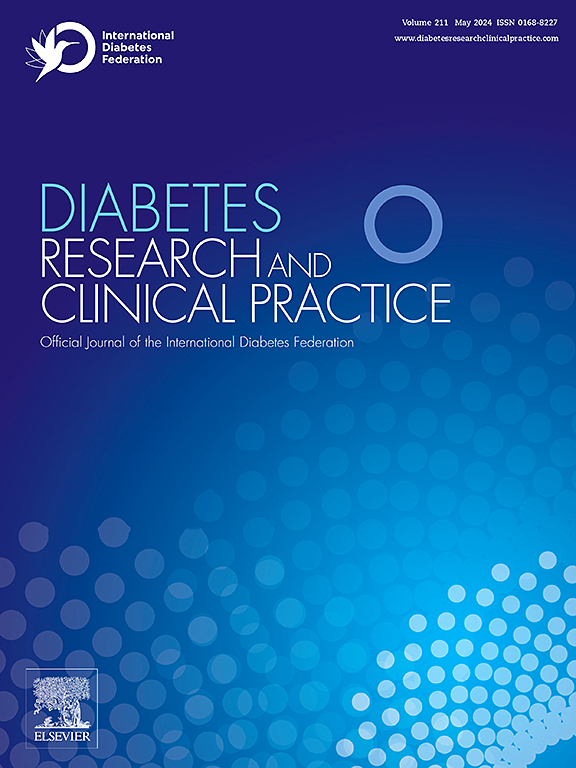Novel data-driven pathophysiological phenotypes among women with prediabetes in an Indian population
IF 7.4
3区 医学
Q1 ENDOCRINOLOGY & METABOLISM
引用次数: 0
Abstract
Aims
Data on pathophysiological phenotypes for prediabetes in Indian ethnic populations are scarce. We investigated data-driven, pathophysiological phenotypes of prediabetes associated with the incidence of diabetes mellitus.
Methods
We characterised pathophysiological prediabetes phenotypes in a survey sample (n = 1455), and its progression to diabetes at one year. Data-driven clusters were identified using k-means cluster algorithm along with measures of glycaemia, adiposity, dyslipidaemia, beta-cell function, insulin resistance and blood pressure. Logistic regression analysis was employed to assess the risk of diabetes incidence.
Results
Four distinct pathophysiological prediabetes phenotypes were identified: Phenotype 1 (Combined Insulin Resistant and Deficient Prediabetes – CIRDP) [n = 323, 22.2 %]; Phenotype 2 (Severe Insulin Resistant Obese Prediabetes – SIROP) [n = 290, 19.9 %]; Phenotype 3 (Severe Insulin Deficient Prediabetes – SIDP) [n = 544, 37.4 %] and Phenotype 4 (High Blood Pressure Moderate Insulin Deficient Prediabetes – HBPMIDP) [n = 298, 20.5 %]. At one year, the progression to diabetes was highest in Phenotype 1-CIRDP (OR: 6.07, 95 % CI: 3.59–10.65), followed by Phenotype 4-HBPMIDP (OR: 2.05, 95 % CI-1.10, 3.87) compared to Phenotype 3-SIDP after adjusting for age, BMI, educational and marital status.
Conclusions
CIRDP and HBPMIDP had higher progression rates to diabetes at one year compared to SIDP. Eighty percent of the pathophysiological prediabetes phenotypes displayed beta-cell dysfunction.

新的数据驱动的病理生理表型的妇女糖尿病前期在印度人口。
目的:关于印度少数民族人群糖尿病前期病理生理表型的数据很少。我们研究了数据驱动的与糖尿病发病率相关的前驱糖尿病的病理生理表型。方法:我们在一个调查样本(n = 1455)中描述了糖尿病前期的病理生理表型,并在一年内进展为糖尿病。使用k-means聚类算法识别数据驱动的聚类,并测量血糖、肥胖、血脂异常、β细胞功能、胰岛素抵抗和血压。采用Logistic回归分析评估糖尿病发病风险。结果:确定了四种不同的病理生理前驱糖尿病表型:表型1(合并胰岛素抵抗和缺陷前驱糖尿病- CIRDP) [n = 323,22.2 %];表型2(重度胰岛素抵抗型肥胖前驱糖尿病- SIROP) [n = 290,19.9 %];表型3(严重胰岛素缺乏前驱糖尿病- SIDP) [n = 544,37.4 %]和表型4(高血压中度胰岛素缺乏前驱糖尿病- HBPMIDP) [n = 298,20.5 %]。一年后,与表型3- SIDP相比,表型1- CIRDP的糖尿病进展最高(OR: 6.07, 95 % CI: 3.59-10.65),其次是表型4- HBPMIDP (OR: 2.05, 95 % CI- 1.10, 3.87),调整了年龄、BMI、教育和婚姻状况。结论:与SIDP相比,CIRDP和HBPMIDP在一年内有更高的糖尿病进展率。80%的病理生理前驱糖尿病表型表现出β细胞功能障碍。
本文章由计算机程序翻译,如有差异,请以英文原文为准。
求助全文
约1分钟内获得全文
求助全文
来源期刊

Diabetes research and clinical practice
医学-内分泌学与代谢
CiteScore
10.30
自引率
3.90%
发文量
862
审稿时长
32 days
期刊介绍:
Diabetes Research and Clinical Practice is an international journal for health-care providers and clinically oriented researchers that publishes high-quality original research articles and expert reviews in diabetes and related areas. The role of the journal is to provide a venue for dissemination of knowledge and discussion of topics related to diabetes clinical research and patient care. Topics of focus include translational science, genetics, immunology, nutrition, psychosocial research, epidemiology, prevention, socio-economic research, complications, new treatments, technologies and therapy.
 求助内容:
求助内容: 应助结果提醒方式:
应助结果提醒方式:


